4-trifluoromethyl derivatives of salicylate, triflusal and its main metabolite 2-hydroxy-4-trifluoromethylbenzoic acid, are potent inhibitors of nuclear factor kappaB activation
- PMID: 10217529
- PMCID: PMC1565913
- DOI: 10.1038/sj.bjp.0702441
4-trifluoromethyl derivatives of salicylate, triflusal and its main metabolite 2-hydroxy-4-trifluoromethylbenzoic acid, are potent inhibitors of nuclear factor kappaB activation
Abstract
1. The effect of two derivatives of salicylate, 2-hydroxy-4-trifluoromethylbenzoic acid (HTB) and 2-acetoxy-4-trifluoromethylbenzoic acid (triflusal), on the activation of NF-kappaB elicited by tumour necrosis factor-alpha (TNF-alpha) on human umbilical vein endothelial cells (HUVEC) was tested. 2. The expression of the mRNA of vascular cell adhesion molecule-1 (VCAM-1) was studied as an example of a gene the expression of which is regulated by NF-kappaB. To extend these findings to other systems, the induction of nitric oxide synthase in rat adherent peritoneal macrophages was studied. 3. Both HTB and triflusal were more potent than aspirin or salicylate as inhibitors of the nuclear translocation of NF-kappaB. The calculation of the IC50 values showed approximately 2 mM for HTB, 4 mM for aspirin and >4 mM for salicylate. 4. Comparison of the potency of these compounds on VCAM-1 mRNA expression showed complete inhibition by both triflusal and HTB at a concentration of 4 mM whereas aspirin and salicylate produced only 36-43% inhibition at the same concentration. 5. Inhibition of NF-kappaB activation was also observed in rat peritoneal macrophages stimulated via their receptors for the Fc portion of the antibody molecule with IgG/ovalbumin immune complexes. This was accompanied by a dose-dependent inhibition of nitrite production by the L-arginine pathway via iNOS. IC50 values for this effect were 1.13+/-0.12 mM (triflusal), 1.84+/-0.34 (HTB), 6.08+/-1.53 mM (aspirin) and 9.16+/-1.9 mM (salicylate). 6. These data indicate that the incorporation of a 4-trifluoromethyl group to the salicylate molecule strongly enhances its inhibitory effect on NF-kappaB activation, VCAM-1 mRNA expression and iNOS induction, irrespective of the presence of the acetyl moiety involved in the inhibition of cyclo-oxygenase.
Figures


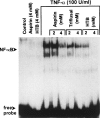

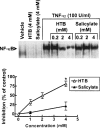

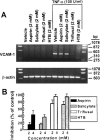
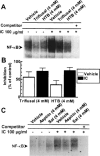
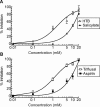
Similar articles
-
Inhibition of cyclooxygenase-2 expression by 4-trifluoromethyl derivatives of salicylate, triflusal, and its deacetylated metabolite, 2-hydroxy-4-trifluoromethylbenzoic acid.Mol Pharmacol. 1999 Apr;55(4):753-60. Mol Pharmacol. 1999. PMID: 10101034
-
Effect of 4-trifluoromethyl derivatives of salicylate on nuclear factor kappaB-dependent transcription in human astrocytoma cells.Br J Pharmacol. 2001 Jan;132(2):547-55. doi: 10.1038/sj.bjp.0703820. Br J Pharmacol. 2001. PMID: 11159705 Free PMC article.
-
Acetaminophen inhibits iNOS gene expression in RAW 264.7 macrophages: differential regulation of NF-kappaB by acetaminophen and salicylates.Biochem Biophys Res Commun. 2000 Jun 16;272(3):758-64. doi: 10.1006/bbrc.2000.2863. Biochem Biophys Res Commun. 2000. PMID: 10860828
-
Triflusal.Drugs. 1998 Jun;55(6):823-33; discussion 834-5. doi: 10.2165/00003495-199855060-00011. Drugs. 1998. PMID: 9617597 Review.
-
Salicylates and vascular smooth muscle cell proliferation: molecular mechanisms for cell cycle arrest.Trends Cardiovasc Med. 2001 Nov;11(8):339-44. doi: 10.1016/s1050-1738(01)00133-5. Trends Cardiovasc Med. 2001. PMID: 11728884 Review.
Cited by
-
Comparative effects of triflusal, S-adenosylmethionine, and dextromethorphan over intestinal ischemia/reperfusion injury.ScientificWorldJournal. 2011;11:1886-92. doi: 10.1100/2011/583603. Epub 2011 Oct 24. ScientificWorldJournal. 2011. PMID: 22125445 Free PMC article.
-
Triflusal reduces dense-core plaque load, associated axonal alterations and inflammatory changes, and rescues cognition in a transgenic mouse model of Alzheimer's disease.Neurobiol Dis. 2010 Jun;38(3):482-91. doi: 10.1016/j.nbd.2010.01.019. Epub 2010 Feb 10. Neurobiol Dis. 2010. PMID: 20149872 Free PMC article.
-
Access of HTB, main metabolite of triflusal, to cerebrospinal fluid in healthy volunteers.Eur J Clin Pharmacol. 2005 Apr;61(2):103-11. doi: 10.1007/s00228-004-0887-0. Epub 2005 Feb 12. Eur J Clin Pharmacol. 2005. PMID: 15711832 Clinical Trial.
-
Triflusal: a review of its use in cerebral infarction and myocardial infarction, and as thromboprophylaxis in atrial fibrillation.Drugs. 2006;66(5):671-92. doi: 10.2165/00003495-200666050-00009. Drugs. 2006. PMID: 16620146 Review.
-
Diethylcarbamazine reduces chronic inflammation and fibrosis in carbon tetrachloride- (CCl₄-) induced liver injury in mice.Mediators Inflamm. 2014;2014:696383. doi: 10.1155/2014/696383. Epub 2014 Oct 13. Mediators Inflamm. 2014. PMID: 25374445 Free PMC article.
References
-
- AEBERHARD E.E., HENDERSON S.A., ARABOLOS N.S., GRISCAVAGE J.M., CASTRO F.E., BARRETT C.T., IGNARRO L.J. Nonsteroidal anti-inflammatory drugs inhibit expression of the inducible nitric oxide synthase gene. Biochem. Biophys. Res. Commun. 1995;208:1053–1059. - PubMed
-
- ANRATHER D., MILLAN M.T., PALMETSHOFER A., ROBSON S.C.G.C., RITCHIE A.J., BACH F.H., EWENSTEIN B.M. Thrombin activates nuclear factor-κB and potentiates endothelial cell activation by TNF. J. Immunol. 1997;159:5620–5628. - PubMed
-
- BACH F.H., HANCOCK W.W., FERRAN C. Protective genes expressed in endothelial cells: a regulatory response to injury. Immunol. Today. 1997;18:483–486. - PubMed
-
- BAYON Y., ALONSO A., SANCHEZ CRESPO M. Stimulation of Fcγ receptors in rat peritoneal macrophages induces the expression of nitric oxide synthase and chemokines by mechanisms showing different sensitivities to antioxidants and nitric oxide donors. J. Immunol. 1997;159:887–894. - PubMed
Publication types
MeSH terms
Substances
LinkOut - more resources
Full Text Sources
Other Literature Sources
Medical
Miscellaneous

